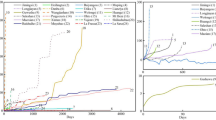Abstract
A systematic analysis was conducted of the different variability components that affect the prediction of \(\text{ log }_{10}(PSA)\) (i.e., Pseudo-Spectral Acceleration) ordinates on (mostly) deep sedimentary soil sites using a sizable set of strong motion data recorded in the strong earthquake sequences of 2010 and 2012 in the Canterbury region of New Zealand. Following recent, well established approaches of residual analysis of ground motion predictions, as well as recent GMPEs based on a global dataset, it was found that the event-corrected single-station standard deviation (“sigma”) is strongly decreased, for all selected stations, with respect to the uncorrected sigma. Likewise, the event-corrected intraevent sigma estimated for the entire dataset is significantly reduced compared to the standard deviation associated to ground motion prediction models, i.e. the “ergodic” sigma, for all spectral periods. The event-corrected sigma values for the present dataset are surprisingly consistent with those recently derived using KiK-Net strong motion data from Japan and those by Boore and Atkinson (Earthq Spectra 34(1):99–138, 2008) GMPE, and remain fairly constant with respect to the spectral period at about \(0.15\sim 0.2\). An interpretation was provided of the physical meaning of the site correction term (\({\delta }S2S)_{s}\) indicating a plausible correlation with prevailing geological conditions in the site area.















Similar content being viewed by others
References
Al Atik L, Abrahamson NA, Bommer JJ, Scherbaum F, Cotton F, Kuehn N (2010) The variability of ground-motion prediction models and its components. Seismol Res Lett 81(5):794–801
Anderson JG, Brune JN (1999) Probabilistic seismic hazard assessment without the ergodic assumption. Seismol Res Lett 70(1):19–28
Atkins RAE, Hicks SR (2012) Geophysical models along Ashburton River, Canterbury, New Zealand. NZ J Geol Geophys 22(6):673–677
Atkinson GM (2006) Single station sigma. Bull Seismol Soc Am 96(2):446–455
Bommer JJ, Abrahamson NA (2006) Why do modern probabilistic seismic hazard analyses often lead to increased hazard estimates? Bull Seismol Soc Am 96(6):1967–1977
Boore MB, Atkinson GM (2008) Ground motion prediction equations for the average horizontal component of PGA, PGV and 5%-damped PSA at spectral periods between 0.01s and 10.0s. Earthq Spectra 34(1):99–138
Bradley BA, Cubrinovski M (2011) Near-source strong ground motions observed in the 22 February 2011 Christchurch earthquake. Seismol Res Lett 82(6):853–864
Cauzzi C, Faccioli E (2008) Broadband (0.05 to 20s) prediction of displacement response spectra based on worldwide digital records. J Seismol 12(4):453–475
CEN, European Committee for Standardization (2004) Eurocode 8: design of structures for earthquake resistance-Part 1: general rules, seismic actions and rules for buildings, Bruxelles
Choi Y, Stewart JP, Graves RW (2005) Empirical model for basin effects accounts for basin depth and source location. Bull Seismol Soc Am 95:1412–1427
Cubrinovski M, Green RA, Wotherspoon L (eds) (2011) Geotechnical reconnaissance of the 2011 Christchurch. New Zealand Earthquake, Report of geo-engineering extreme event reconnaissance (GEER), USA
Douglas J, Boore D (2011) High-frequency filtering of strong-motion records. Bull Earthquake Eng 9(2):395–409
Faccioli E, Bianchini A, Villani M (2010) New ground motion prediction equations for T>1s and their influence on seismic hazard assessment. In: Proceedings of the University of Tokyo symposium on long-period ground Motion and Urban Disaster Mitigation, Tokyo, Japan
Faccioli E, Chen L (2012) Single-station standard deviation for probabilistic seismic hazard analyses at representative sites in the Po Plain, Northern Italy. In: Proceedings workshop in honor and memory of Prof. Giuseppe Grandori, November 5, 2012, Milan, Italy
Green RA, Cubrinovski M (editors) (2010) Geotechnical reconnaissance of the 2010 Darfield (New Zealand) Earthquake. Report of geo-engineering extreme event reconnaissance (GEER), USA
Ornthammarath T, Douglas J, Sigbjörnsson R, Lai CG (2011) Assessment of ground motion variability and its effects on seismic hazard analysis: a case study for Iceland. Bull Earthquake Eng 9(4):931–953
Rodriguez-Marek A, Montalva GA, Cotton F, Bonilla F (2011) Analysis of single-station standard deviation using the KiK-net data. Bull Seism Soc Am 101(2):1242–1258
Segou M, Kalkan E (2011) Ground motion attenuation during M7.1 Darfield and M6.2 Christchurch, New Zealand, earthquakes and performance of global predictive models. Seism Res Lett 82(6):866–874
Strasser FO, Abrahamson NA, Bommer JJ (2009) Sigma: issues, insights and challenges. Seism Res Lett 80(1):40–56
New Zealand Standard (NZS 1170.5:2004) (2004) Structural design actions part 5: earthquake actions - New Zealand, New Zealand
Acknowledgments
We are grateful to Manuela Vanini, Manuela Villani and Chiara Smerzini who helped with the software for the sigma calculation. John Douglas and an anonymous reviewer provided valuable comments, which contributed to significant improvements in the paper. Roberto Paolucci, Mario Ordaz and Fabrice Cotton also made insightful comments on the work. The Dipartimento di Ingegneria Strutturale of Politecnico di Milano hosted the first author as a visiting post-doctoral fellow while carrying out the research. Financial support for the visit was provided by the Earthquake-Specific Research Program of the Chinese Ministry of Science and Technology (201308015); the Chinese Scholarship Council is also gratefully acknowledged.
Author information
Authors and Affiliations
Corresponding author
Rights and permissions
About this article
Cite this article
Chen, L., Faccioli, E. Single-station standard deviation analysis of 2010–2012 strong-motion data from the Canterbury region, New Zealand. Bull Earthquake Eng 11, 1617–1632 (2013). https://doi.org/10.1007/s10518-013-9454-3
Received:
Accepted:
Published:
Issue Date:
DOI: https://doi.org/10.1007/s10518-013-9454-3




